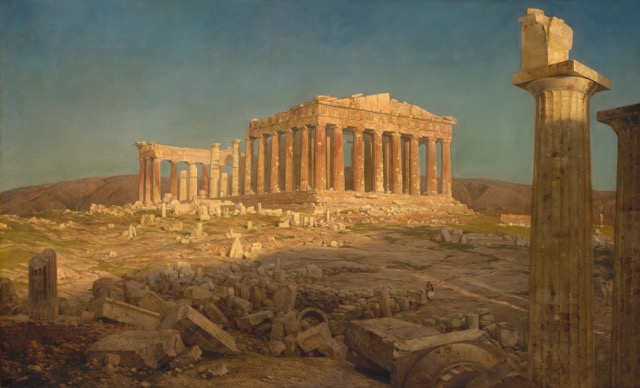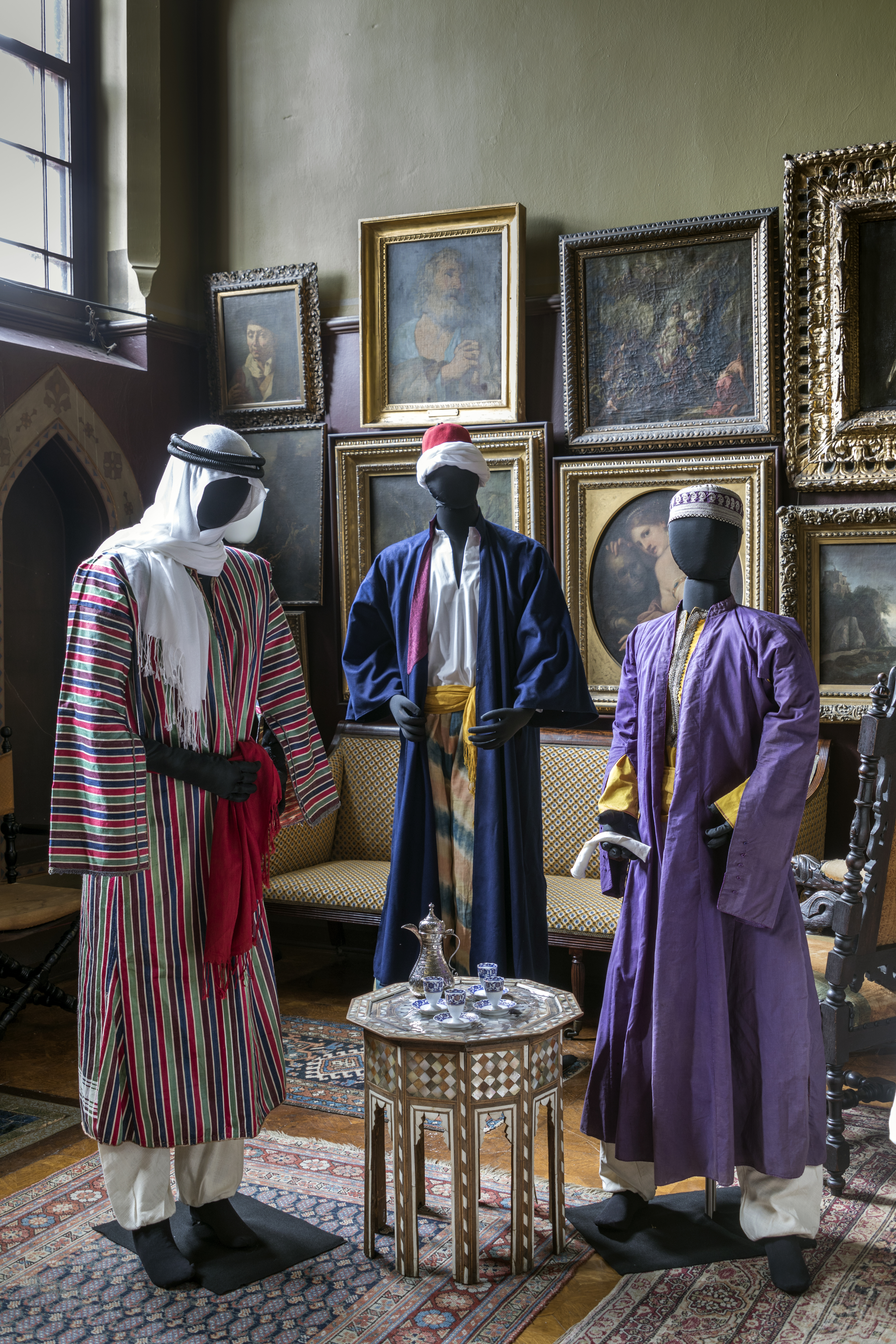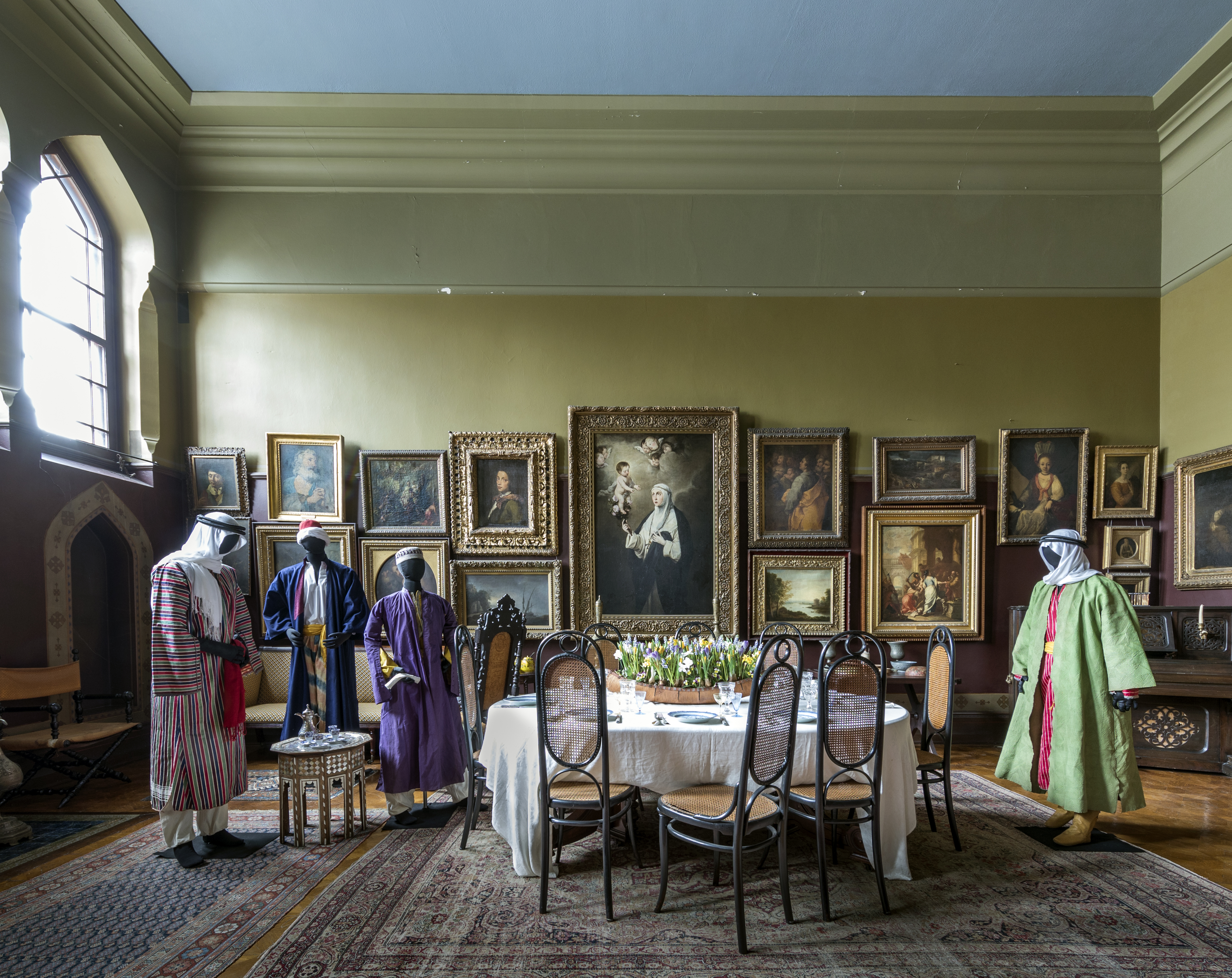Frederic Church: A Painter’s Pilgrimage and Costume & Custom: Middle Eastern Threads at Olana
Frederic Church: A Painter’s Pilgrimage
Curated by: Kenneth John Myers
Exhibition schedule: Detroit Institute of Arts, October 22, 2017–January 15, 2018; Reynolda House Museum of American Art, Winston-Salem, NC, February 8–May 13, 2018; Wadsworth Atheneum Museum of Art, Hartford, CT, June 3–August 26, 2018
Exhibition catalogue: Kenneth John Myers, Kevin J. Avery, Gerald L. Carr, and Mercedes Volait, Frederic Church: A Painter’s Pilgrimage, exh. cat. Detroit Institute of Arts, in association with Yale University Press, 2017. 224 pp.; 125 color illus.; 10 b/w illus. Paperback $45.00 (ISBN: 9780300218435)
Costume & Custom: Middle Eastern Threads at Olana
Curated by: Lynne Zacek Bassett
Exhibition schedule: Olana State Historic Site, Hudson, NY, June 17–November 25, 2018
Exhibition catalogue: Lynne Zacek Bassett, Costume & Custom: Middle Eastern Threads at Olana. Hudson, NY: Olana Partnership, 2018.

Almost a half century before T. E. Lawrence left London for Damascus, famously donning Arab garb and heading across the desert on the back of a camel, Frederic Church (1826–1900) was photographed at Beirut, his head wrapped in a sun-protective scarf astride his dromedary, ready to set off on his exploration of the Holy Land. (Church’s stunning rendering of a Standing Bedouin (1868; fig. 1) in a carefully rendered costume, wielding a dagger, reinforces the association.) Of course Church had his year-old son perched in front of him, his wife nearby on a donkey, and his mother-in-law not far away. It was, however, just as daring for an American landscape painter to depart in 1867 for almost two years in the region as it was for Lawrence in 1909 to join an archaeological excavation in Syria and eventually the Arab Revolt. Where did Church and his family visit? What were the artistic results of his investigations? And what motivated this Old World quest of America’s leading landscapist? To answer these questions Kenneth John Myers organized a thoughtful and visually stimulating exhibition and related publication—the first to focus exclusively on that trip—entitled Frederic Church: A Painter’s Pilgrimage. The exhibition opened at the Detroit Institute of Arts, where Myers is curator of American art, then traveled to Reynolda House Museum of American Art in Winston-Salem, NC, and ended the tour at the Wadsworth Atheneum Museum of Art, Hartford, CT. Exploring in depth the nineteen months that Church explored Europe and the Holy Land, the exhibition features seventy artworks created out of those experiences, produced from the late 1860s through the early 1880s. For the related book, Myers assembled an expert team of authors: Kevin J. Avery, senior research scholar at The Metropolitan Museum of Art; Gerald L. Carr, independent scholar; and Mercedes Volait, director of the research center InVisu at the Institut national d’histoire de l’art, Paris.
The question of what motivated Church’s travels to the Levant is complicated, as he—like most artists—left little in the way of direct explanation for his actions. Acclaimed in the 1850s as the greatest of American painters, he was being eclipsed in the late sixties by a younger, European-trained generation and was therefore in search of fresh inspiration. He was no longer a bachelor on his own but was now traveling with his family, transitioning from explorer to tourist. And following the horrors of the Civil War, he and his wife lost their two young children to diphtheria, a tragedy that would have shaken even faith as strong as theirs. Church’s adherence to the precepts of the Congregational Church remained strong throughout his life, even to the point of refraining from painting on the Sabbath. [In Hartford, the exhibition opened with Church’s early painting of his ancestor Reverend Thomas Hooker and Company Journeying through the Wilderness from Plymouth to Hartford in 1636 (1846; Wadsworth Atheneum Museum of Art, Hartford, CT) that documents this faith, but to my mind, sends the viewer on a detour right at the start.] He also enjoyed close friendships with ministers the Rev. Louis Legrand Noble and the Rev. George Washington Bethune. His life and art universally possessed a spiritual dimension. A pilgrimage is a journey made as an act of religious devotion to a location of import to the person’s faith and beliefs. Human activity as complex and varied as a pilgrimage, however, has no universally accepted definition. Frederic Church: A Painter’s Pilgrimage opens new vistas onto a lesser-known aspect of this renowned artist’s career and rewards us with new understanding of his quest to render these sacred spaces for himself and his American public.
Focusing on this later episode in Church’s career, this exhibition invited the visitor to follow his journey by moving through the galleries where the visitor encountered a succession of major paintings conceived of Rome, Athens, Jerusalem, Petra and Syria, and its environs. For each geographic location, the large, finished painting was hung with related small studies, allowing the viewer to follow the artist’s extended engagement with this key site from on-the-spot observations to studio productions. The closing segment was devoted to Olana, the artist’s magnificent country estate overlooking the Hudson River that was inspired by his Middle Eastern travels. Before his departure Church had acquired the property and consulted with Richard Morris Hunt to construct a French château, but upon his return he “designed the house myself” to embody his immersion in Islamic architecture.1 The home and grounds are here represented by a handful of studies such as East Façade, Olana (c. 1870; Olana State Historic Site, Hudson, NY) and Olana from the Southwest (c. 1872; Cooper Hewitt, Smithsonian Design Museum, NY).2 The exhibition makes implicit comparisons between these painted scenes associated with ancient civilizations and biblical texts and his earlier canvases depicting the landmarks of North and South America, arguing for a career-defining shift from natural history to human history. However, the New World paintings, categorized as being preoccupied with natural history, are offstage, alluded to but not displayed. Myers and his team leave it largely to the viewer to conjure up this dichotomy they posit in Church’s work equating the New World with nature and the Old World with civilization.
Highlights of the Exhibition
Jerusalem from the Mount of Olives (1870; fig. 2) provided the spectacular centerpiece of the exhibition. Just below the horizon line of the 4 ½ x 7 ft. canvas—at a significant distance from the travelers who have halted on the central foreground plateau of the exhibition—is the string of architectural structures that make up the walled city topped by the gold-leaf Dome of the Rock. When it was completed and first shown at Goupil’s in New York, a numbered key was inserted into the invitations identifying the sites: Tomb of Absalom, Tomb of the Virgin, Garden of Gethsemane, Church of the Holy Sepulchre, Islamic monuments, Dome of the Rock, and al-Aqsa Mosque. Along the bottom of the key was printed: “The Spectator is supposed to stand in the early spring on the Mount of Olives, facing West.”3 Visitors to the gallery were being urged to make their own pilgrimages vicariously, slowly absorbing the detail the artist had infused into his painting. I regret that I was unable to see the exhibition at Reynolda House, where Church’s The Andes of Ecuador (1855) is in the permanent collection, with mountain peaks—like the man-made structures of Jerusalem—strung along the middle distance: Cayambe, the twin Illinisas, and Cotopaxi. Setting up a dialogue between the Old and New Worlds, Church created kindred panoramas of the geology of the Americas and the historic markers of the Holy Land set in their own distinctive landscapes.

The Mount of Olives became a special place for Church and his wife, who enjoyed the privilege of camping out overnight on its summit: “From Olivet at sunset,” Isabel Church wrote, “all your expectations are realized, and Jerusalem is beautiful.” Her words parallel those of her husband from 1853, when he traversed the Andes through the Quindío Pass, and declared: “my ideal of the Cordilleras is realized.” A single, historied locale in each case catalyzed a strong aesthetic and spiritual reaction. That night, “we read appropriate portions of the New Testament,” Isabel continued, “and very sweet and sad and solemn they seemed.”4 The show included a selection of the many small works Church made from this vantage point: a pencil drawing Effect of Light on Jerusalem (1868; Cooper Hewitt, Smithsonian Design Museum, New York) and an open, loosely painted oil study Jerusalem from the Mount of Olives (1868; Cooper Hewitt, Smithsonian Design Museum, New York) register both optical and religious responses to this hallowed city. Just as the palm tree emblematized the tropics in Church’s Latin American works, so the hoary olive tree became the genius loci of his biblical panoramas, strategically placed in the right foreground of this Jerusalem study.

The Parthenon (1871; fig. 3) is an old favorite I have studied many times at The Metropolitan Museum of Art, but seeing it here, surrounded by small preparatory studies and other large-scale paintings for comparison, provided invaluable context that led to new insights. Parthenon at Night, Athens (1869; Cooper Hewitt, Smithsonian Design Museum, New York), for example, demanded attention, with the temple’s marble columns reflecting rosy red, while the interior glows with a whitish-blue light. Coming upon this small oil study, the visitor might momentarily speculate that Church for once abandoned empiricism to create this otherworldly vision. But such was not the case. On April 21, 1869, he was among the throng that witnessed the ancient site “a fair subject for blue lights, red lights, green lights, fireworks, and dazzling displays” to celebrate the visit of the Prince and Princess of Wales. “It was to some purpose that this, the most venerable and sacred locality in the classical world,” as the British press reported, “was for once turning into a fairy transformation scene.”5 The artist had studied the edifice at sunrise and sunset, at midday under sunny and cloudy skies, and through the lens of this multicolored extravaganza. For the large-scale finished canvas, he adopted the same vantage point from the northwest he occupied for the night view but substituted a homogeneous, brittle blue sky with the faintest wisp of clouds. Although The Parthenon was later criticized for its conventional, picture-postcard quality, that was likely the artist’s aim: this enduring moment is an object of wonder in itself; no pyrotechnics required.
El Khasné, Petra (1874; Olana State Historic Site, Hudson, NY) rounds out this group of site-specific studio compositions from the Mediterranean. Depicting a rock temple in present-day Jordan, it vividly captures Church’s written description “not of the picture but the real scene”:
The chief approach to Petra is through a wild, rocky ravine known as El Sik. As the traveler emerges from the blackness of this narrow defile, his eyes are dazzled by a sudden blaze of rosy light, whose delicate tints presenting reveal the form of the Corinthian Temple, luminous in its own glowing color. The Temple, known as El Khasne, is cut out of solid rock, and stands on a cross ravine, directly opposite the Sik.6
This landmark is represented in the exhibition by several small works, including an oil sketch of the magnificent structures carved into the stone mentioned by the artist: The Urn Tomb, Silk Tomb, and Corinthian Tomb, Petra (1868; Olana State Historic Site, Hudson, NY). Since it was unavailable for loan, the finished work must be seen at Olana. There it hangs in the sitting room of Isabel Church—to whom her husband gave the painting—the decoration of which was inspired by their travels, especially the painted pseudo-Arabic inscriptions that run throughout the space.

Harder to appreciate—in the artist’s day as in our own—are the twenty-odd paintings here designated as “Idealized Landscapes.” Assemblages of motifs from various sites, they are deliberately generalized in location and include Syria by the Sea (1873; fig. 4), Springtime in the Levant (1878; private collection), and On the Mediterranean (1882; Olana State Historic Site, Hudson, NY). From early on, Church painted composite pictures. To create works such as The Heart of the Andes (1859; The Metropolitan Museum of Art), he selected a waterfall he encountered in one spot and a roadside shrine from another and joined them with a favored mountain perspective. His American works invariably combined related elements into a seamless whole that conveyed the illusion of a single locale. But in works such as Syria by the Sea—the first major nineteenth-century painting acquired by the Detroit Institute of Arts—Church relinquished even the illusion of representing an individual site. These capriccios or fantasies of crumbling ruins in sunlit landscapes embody an affirmation of Old World civilizations for the future of the New World.
Olana evolved to become a family home, a salon where guests assembled regularly, an artist’s studio, a library, and a working farm. It was also a wunderkabinett, a magical repository for the souvenirs the Churches gathered on their travels. Paintings purchased in Mexico as Old Masters, Persian tiles, dried flowers from Jamaica, and Mexican hats were displayed in every room. The annual exhibition held there in 2018, entitled Costume & Custom: Middle Eastern Threads at Olana, complements the Wadsworth exhibition by bringing into the spotlight another little-known dimension of those holdings: the clothing and textiles acquired in the Middle East. Organized by guest curator Lynne Zacek Bassett, it features more than forty of the best examples from what is now recognized as one of the oldest surviving collections of Bedouin and Palestinian costume.


Touring the historic house during the exhibition, visitors encounter mannequins bedecked in richly textured robes, vests, and headgear strategically placed at the foot of the staircase, in the picture gallery, or beside the dining table set with mixed porcelain patterns (figs. 5, 6). The juxtaposition of the painting El Khasné, Petra, with a figure displaying dress from the region, is especially striking. The Sharp Gallery on the second floor features additional clothing, accessories, and related works: richly colored figure studies alongside careful pencil drawings of Arab men and women that the artist labeled with individual dress components spelled out phonetically. The costumes were not only aide-mémoire for future paintings and home decoration, but dinner guests were also encouraged to go to the “costume cabinet” and select a thob (women’s loose-fitting garment) or qumbaz (a long-sleeved men’s tunic) to wear for the evening.
Concluding Thoughts
Inevitably, these two exhibitions prompt us to consider Church’s travels, collecting, and art in relation to Orientalism, defined as a way of seeing that imagines, exaggerates, and distorts differences between Arab culture and that in Europe and the United States. This mind-set involves seeing Arabs as exotic, backward, and even dangerous and provided a rationalization for colonialism, as Edward Said argued, based on the idea that “the East” was inferior and in need of Western intervention.7 Providing the opportunity to see so much of Church’s work from the Middle East as an ensemble, these exhibitions—accompanied by informative publications—encourage a rethinking of this discourse and Church’s relation to it.
Strolling through the rooms in Church’s home and the galleries of the Wadsworth Atheneum, studying the fruits of Church’s extended immersion in Greece and the Middle East, I began to ponder numerous parallels and intersections with his earlier work across the Americas. Alexander von Humboldt’s natural history explorations—as is well known—guided Church’s itinerary on his two trips to South America in 1853 and 1857. But later, as a mature artist traveling in a part of the world where Humboldt never set foot—I began to think—the German naturalist was still guiding him, through his five-volume summation of universal knowledge entitled Cosmos (1850–60). Just as Humboldt’s vision evolved from specific observation to a holistic view of nature, so too did Church’s vistas widen as he ventured farther afield geographically and had the opportunity to recognize—as did his scientific mentor—the unity in the diversity of the world’s nature and culture. Thinking about Church’s entire oeuvre—embracing Olana and all his paintings—as a totality instead of a linear progression, it can be interpreted as the pictorial equivalent to Humboldt’s Cosmos, his synthesis of observations acquired over a lifetime of global travel and art making.
Cite this article: Katherine Manthorne, review of Frederic Church: A Painter’s Pilgrimage (Wadsworth Atheneum) and Costume & Custom: Middle Eastern Threads at Olana (Olana State Historic Site), Panorama: Journal of the Association of Historians of American Art 4, no. 2 (Fall 2018), https://doi.org/10.24926/24716839.1675.
PDF: Manthorne-review-of-Frederic-Church
- Kenneth John Myers, Kevin J. Avery, Gerald L. Carr, and Mercedes Volait, Frederic Church: A Painter’s Pilgrimage, exh. cat. (New Haven: Yale University Press, 2017), 192. ↵
- Mercedes Volait, “Idealized Landscapes,” in Myers, Frederic Church, 193–210. ↵
- John Davis, “Frederic Church’s ‘Sacred Geography,’” Smithsonian Studies in American Art 1 (Spring 1987): 89; Davis’s work is seminal to the current exhibition. ↵
- As quoted in Davis, “Frederic Church’s ‘Scared Geography,” 88. ↵
- As quoted in Kevin J. Avery, “’The Finest Edifice on the Finest Site in the World’: Church’s Parthenon,” in Myers, Frederic Church, 177, n. 71. ↵
- Avery, “The Finest Edifice on the Finest Site in the World,” 58. ↵
- Edward Said, Orientalism (New York: Random House, 1979) was a groundbreaking study. ↵
About the Author(s): Katherine Manthorne is Professor of Art of the United States, Latin America, and Their Cross Currents, 1750–1950, The Graduate Center, City University of New York

